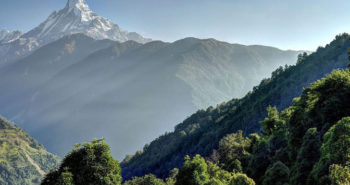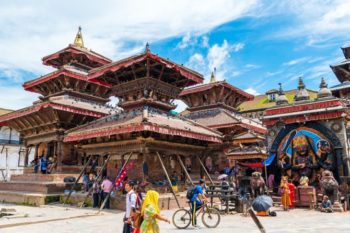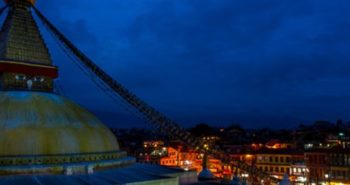When is the Best Time to go on the Ghorepani Poonhill Trek?
Now you have decided to go on the Ghorepani Poon Hill Trek, you want to know when is the best time to go. The Ghorepani Poon Hill Trek is a four-season trek, with teahouses open even in the winter months.
There are benefits and disadvantages in each season and you have to think about the balance of weather and vegetation against the number of other trekkers on the route.
Here is a breakdown season by season.
Spring – March through May
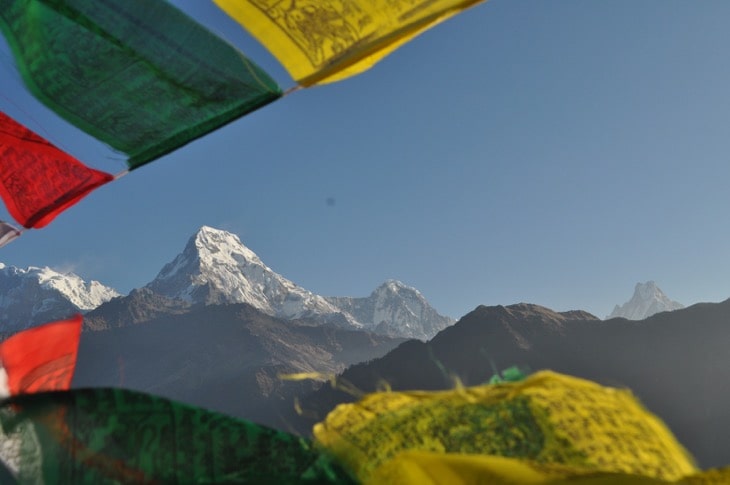
As this trek is at a relatively low altitude, the days during March to May are warm and sunny. All you will need to wear is a t-shirt. But do remember warmer clothes for early morning and evenings. And Poon Hill is always chilly!
The vegetation is in full bloom at this time of year. Nepal’s national flower, the rhododendron, is a highlight of radiant colour. Those who have trekked in Nepal during this time of year always refer to the rhododendrons when they reminisce about their trek.
Temperatures will range between 10 to 24oC, with the temperature on Poon Hill itself dropping to freezing point. That’s when we are really happy they serve tea and coffee during the sunrise vigil!
There is no rain during this time and the skies will be clear.
Monsoon – June through August
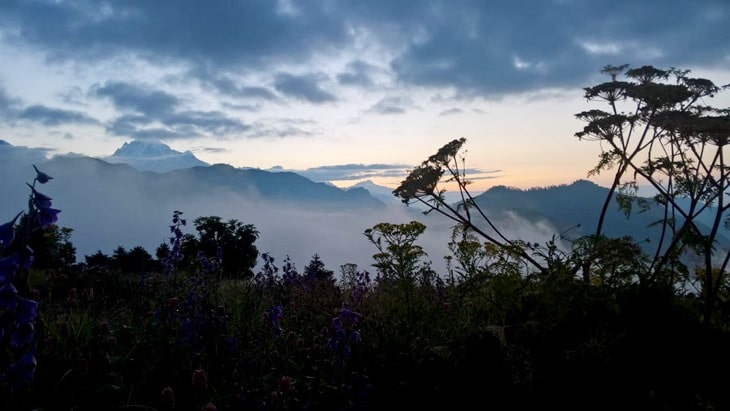
There is something wonderful that we love about monsoon! Vegetation is washed clean, and the snow-capped mountains are stunning in the mornings after a night of rain. There will be times when the mountains will disappear behind rain clouds, but that just makes it all the more special when they do appear!
Teahouses are open during this time, and with less trekkers around, accommodation is not a problem. You might even be able to get a cheaper rate than that advertised.
Temperatures are not so different from those of the springtime, being perhaps a bit less cold at the higher points of this trek. Expect temperatures around 9 to 24oC, with drops when it rains.
You might ask how much does it rain during the monsoon? Unless you are really unlucky, monsoon does not mean downpours 24/7! You might be lucky and have no rain at all. But most common will be some rain for short periods every day
The disadvantages of trekking in the monsoon are the leeches (they do not pass disease but can cause infection if you scratch the bite site) and the fact the trails will be more slippery.
The main advantage of trekking in the monsoon is the fact you will not see many other trekkers. And we think that offsets those horrible little leeches! (Carry salt to remove them.) And drinking hot tea inside your teahouse watching the rain falling outside can be just as magical an experience as gazing at the mountains.
A good pair of walking shoes or trekking boots and trekking poles (sticks) will help you negotiate any slippery parts of the trail.
Autumn – September through November
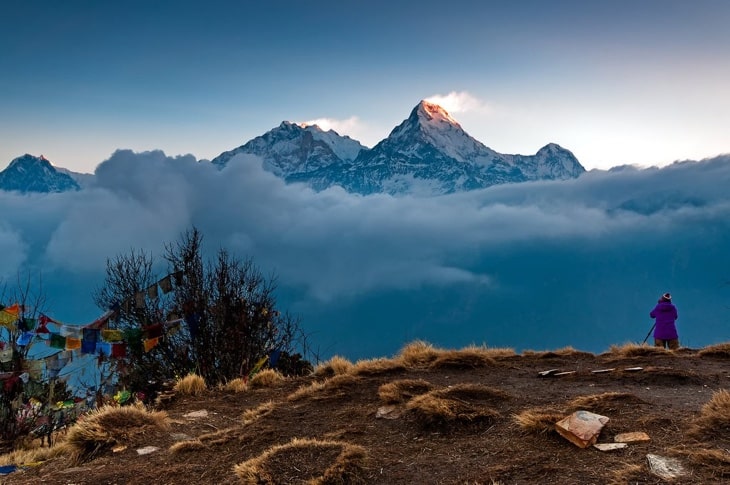
This is perhaps the best time to trek the Himalayas. As a result, the trails will be busier. So again, off-set the weather and beauty of the surroundings with the fact the there will be more trekkers around and accommodation is at a premium.
Also bear in mind this is the main festival season in Nepal – sort of like the Western Christmas and New Year. So if you are planning to travel with a porter and/or guide, please make sure to book them in advance.
With peak trekking season and festival season falling at the same time, trekking staff are stretched to the limit! There are only 2 or 3 days however when things will be affected – such as less road transport during the main festival days. Please bear this in mind when planning your trek.
On the other hand, you can enjoy the festive atmosphere along the way and in Pokhara, the starting and ending point of this trek.
Temperatures are similar to spring, getting cooler as the season gets later. But expect in the region of 10 to 24oC, with the temperature on Poon Hill itself dropping to freezing point.
Winter – December through February
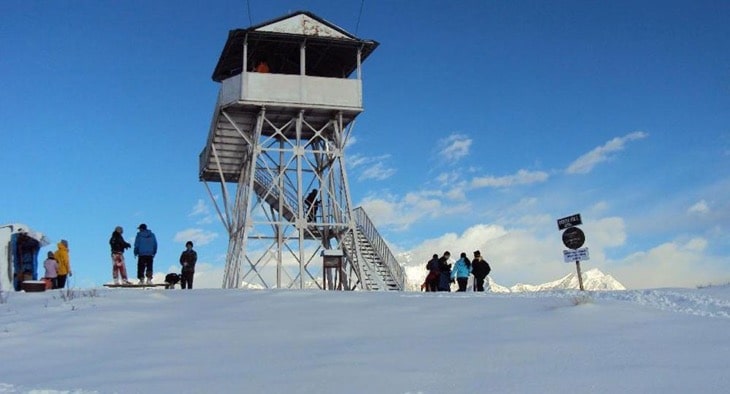
As the Ghorepani Poon Hill Trek is a low altitude trek (compared to other Himalaya treks), the trails are open during the winter. Warm clothing is a must as temperatures will drop to freezing in the mornings and evenings.
At lower altitudes you can still get day time temperatures around 15oC, very comfortable for hiking. Overall it does not rain at this time of the year (let’s say ‘it rarely rains’). There may be some light snow.
There will be less trekkers on the trail, and no problem getting accommodation at teahouses. And all teahouses have lovely warm fires to sit around in the evening over a cup of something hot.
Mountain views will be stunning in the frosty air so for those who don’t mind a little cold this is a great time to trek the Ghorepani Poon Hill trail!
If you would like to know about the best time for the Ghorepani Poon Hill Trek, or want information on this or any other trek, please get in touch with Magical Nepal.
What Kind of Weather can I expect on the Ghorepani Poon Hill Trek?
As this trek is at a relatively low altitude it never gets really cold. Most of the year round you can get away with trekking in short sleeves during the middle of the day. Obviously warmer clothes are needed for morning and evenings and rain gear is advised during the monsoon.
See the breakdown of weather seasons below.
Spring – March through May
Temperatures will range between 10 to 24oC, with the temperature on Poon Hill itself dropping to freezing point. There is no rain during this time and the skies will be clear.
Monsoon – June through August
Temperatures are not so different from those of the spring time, being perhaps a bit less cold at the higher points of this trek. Expect temperatures around 9 to 24oC, with drops when it rains.
Unless you are unlucky, it is most likely to rain only for a short period every day. You might have no rain at all or it might be a particular wet week when you go.
If you are flexible, you can check the weather forecast ahead of time, bearing in mind this change rapidly. Or just embrace the cool monsoon rains!
Autumn – October through November
Temperatures are similar to spring, getting cooler as the season gets later. But expect in the region of 10 to 24oC, with the temperature on Poon Hill itself dropping to freezing point. The weather is, overall, very temperate and lovely. There is a reason this is the most popular trekking season!
Winter – December through February
As the Ghorepani Poon Hill Trek is a low altitude trek (for the Himalayas!) the trails are open during the winter. Temperatures will drop to freezing in the mornings and evenings.
But at lower altitudes you can still get day time temperatures around 15oC. It is unusual for there to be any rain at this time of year. There may be some snow. Although it will not be heavy snowfalls, in the forested areas the snow may lie for some time making the trails slippery.
What is the Ghorepani Poon Hill Trek-like in the winter?
Day time temperatures will be around 8oC to around 15oC. At night it will fall below zero. Snow is not an issue on this trek in terms of quantity. However, in the forested areas they snow may lie for some time and the trail becomes slippery.
The view of snow-capped mountains will be particularly clear in the crisp, cold air. This season sees fewer trekkers so you will have ample time to enjoy the spectacular views on top of Poon Hill, for example. Teahouses will also be less busy but are open as normal.
Can I Trek Ghorepani Poon Hill in the winter?
With daytime temperatures higher than those in Europe at this time of the year, why not? Trails are less busy, teahouses see less trekkers, so overall it’s a peaceful time to reflect and enjoy the surrounding mountain vistas.
You will need warm gear for mornings and evenings and be prepared for teahouses’ unheated bedrooms. All teahouses do have warm fires in the dining room and/ or kitchen areas.
Do I need microspikes or crampons for a winter trek?
In general, no. This low altitude trek sees little snow on the trails. It is unlikely you will need crampons. Shoes with a strong grip are essential and you might want to carry microspikes in case there is snowfall and walking poles for the more slippery parts of the trail.
Will tea houses be open during the winter and monsoon seasons?
Yes, teahouses will be open in winter and monsoon seasons. They will be less busy so you can enjoy relaxing and peaceful evenings!
Will there be indoor heating during winter?
As mentioned above, teahouses do not provide heating in the bedrooms. The dining rooms will be heated however, and you can sit there until it is time to dive into your sleeping bag! On that topic, it is a good idea to take your own in the winter months for added warmth.
What is the difference between the spring and summer seasons on the Ghorepani Poon Hill Trek?
The main differences are the weather and the number of trekkers on the trails. Spring is second only to Autumn in terms of numbers of trekkers in Nepal. In the summer or monsoon, you will meet far fewer people on the trails.
With regards to weather, springtime is warm and sunny most of the day with temperatures around 10 to 24oC. Light clothing is all you will need during the day, with warm clothing for the chilly mornings and nights. Poon Hill is always much colder, especially at sunrise! Rhododendrons and spring flowers are in bloom, making the trails colourful.
The summer, or monsoon, is a time of rainfall so rain gear is essential. However, unless you are very unlucky, it is unlikely to rain for very long or every day.
Many people do actually enjoy walking in the rain, enjoying the tranquillity that the noise of rainfall brings with it. The trails will be washed clean, making vegetation shine anew.
Will there be leeches on the trail during a summer/monsoon trek?
Yes, due to the heavy downpours and the humid surrounding, you may encounter many leeches, earthworms, and bugs on the trails. A good bug spray and salt are essential items to pack!
Why salt? Well, sprinkle some salt on a leech and it will release its grip on your skin (to get away from the burning salt) and drop off. Leeches do not carry disease.
They are actually quite harmless (unless you get a wound infected by scratching it or letting dirt in). It’s just the thought of something sucking your blood, right?
If you have any further questions about trekking along the Ghorepani Poon Hill trail or any other trek, please get in touch with Magical Nepal for more information, or help in planning and organising your visit to Nepal.
